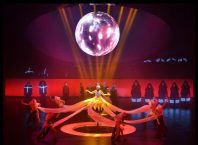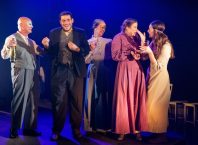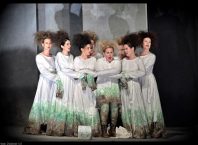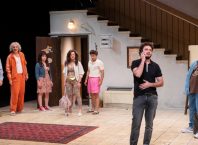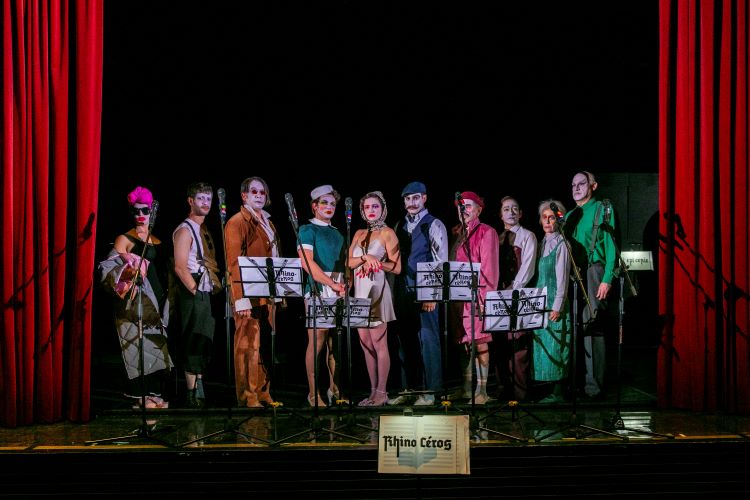
The Beit Lessin production of Eugène Ionesco’s Rhinoceros, directed by Yair Sherman, with a translation into Hebrew by Eli Bijaoui, is visually compelling, fun and playfully subversive, with an imaginative and significant soundscape. The creative team has done a brilliant job of re-imagining Ionescu’s classic play, and the entire cast delivers strong performances.
The play opens like a concert, with music stands set up on which the sheet music says “Rhinoceros” and the cast all line up, emitting strange noises. It’s like a signal: get ready for a wild ride. The cast are all in white face, but these are not happy clowns by any measure, they are more like clowns from a nightmare. As the curtain opens, the set is a gray city square with a grocery and café, brightened by few select touches of colorful neon. Several conversations take place at the same time, a pseudo philosophical discussion offers much amusement, while Jean (Benny Eldar) berates his good friend Bérenger (Tom Hagi) for being a dissolute drunkard. Polina Adamov’s whimsical and imaginative costumes evoke the essence of the different characters wonderfully, and are a delight to behold. My personal favorites are Jean’s vest-corset, and the waitress’s purple velvet short overall. Suddenly, a rumbling sound is heard, and a brief selection of Richard Wagner’s Ride of the Valkyries. A rhinoceros has been sighted as it runs by. It’s the perfect way to show a rhinoceros without showing a rhinoceros.
As the first scene ends, the walls come tumbling down, and the full magnificence of Polina Adamov’s set design is revealed. The different pieces can be assembled like giant building blocks to create different kinds of spaces and moods. Each set is also marked by music stands with sheet music indicating the location, in French, in a nod to the play’s origins. The second scene for example, is the newspaper’s offices where Bérenger works, “le bureau”. The different combinations of gray blocks augment the vivid physicality of this production, offering different possibilities of movement on and among them, whether in romantic or more comic moments. Each scene change takes place in full view of the audience, with the cast clearing and building the set – all to music, of course.
Here is where I think Sherman is at his most subversive. While the charging rhinoceroses get Wagner, each scene change takes place to a lovely, beloved song from the Israeli song book, as performed by the Gevatron chorus. Songs have an undeniable power to inspire, and to unite people. There’s a reason people sing during protest marches. It’s easy to be swept away with the flow of the music. During one scene change, Jean led the song, urging the audience to clap in rhythm. And everyone clapped along. We joined the herd.
More than half a century after it was first written, Ionescu’s play and its social critique remains relevant and though-provoking. It’s not easily digestible fare, it’s very text-heavy. Sherman’s staging lightens the load, and emphasizes the emotional trajectory. Most intriguing is Bérenger, the least heroic hero imaginable. Tom Hagi brings out the character’s vulnerability, and desire to do good, to do better, despite constantly making mistakes. Bérenger’s strength is his ability to admit his weakness and fear.
A note for English speakers:
Rhinoceros has in a way become part of the popular culture in Israel, as the Hebrew word for the animal, karnaf, has come into usage as a verb – lehitkarnef – which means to follow the herd, to conform and submit to a certain norm. In relation to nature, this usage is ironic, as rhinoceroses are solitary animals.


